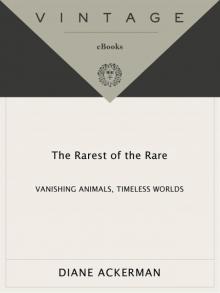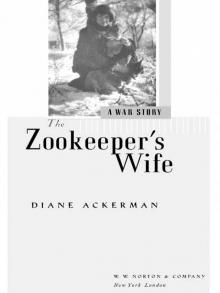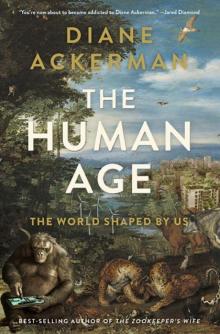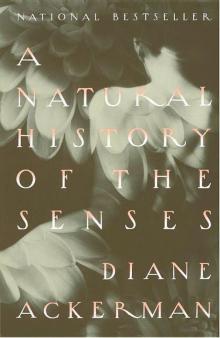- Home
- Diane Ackerman
The Human Age: The World Shaped by Us
The Human Age: The World Shaped by Us Read online
DIANE
ACKERMAN
THE
HUMAN
AGE
THE WORLD SHAPED BY US
W. W. NORTON & COMPANY NEW YORK LONDON
CONTENTS
I.WELCOME TO THE ANTHROPOCENE
Apps for Apes
Wild Heart, Anthropocene Mind
Black Marble
Handmade Landscapes
A Dialect of Stone
Monkeying with the Weather
Gaia in a Temper
Brainstorming from Equator to Ice
Blue Revolution
II.IN THE HOUSE OF STONE AND LIGHT
Asphalt Jungles
A Green Man in a Green Shade
House Plants? How Passé
Opportunity Warms
III.IS NATURE “NATURAL” ANYMORE?
Is Nature “Natural” Anymore?
The Slow-Motion Invaders
“They Had No Choice”
Paddling in the Gene Pool
For Love of a Snail
IV.NATURE, PIXILATED
An (Un)Natural Future of the Senses
Weighing in the Nanoscale
Nature, Pixilated
The Interspecies Internet
Your Passion Flower Is Sexting You
When Robots Weep, Who Will Comfort Them?
Robots on a Date
Printing a Rocking Horse on Mars
V.OUR BODIES, OUR NATURE
The (3D-Printed) Ear He Lends Me
Cyborgs and Chimeras
DNA’S Secret Doormen
Meet My Maker, the Mad Molecule
Conclusion: Wild Heart, Anthropocene Mind (Revisited)
Acknowledgments
Notes
Further Reading
Index
PART I
WELCOME
TO THE
ANTHROPOCENE
APPS FOR APES
On a blue-sky day at the Toronto zoo, flocks of children squired by teachers and parents mingle excitedly between exhibits. Some kids pull out cell phones and send texts or snap pictures with the easy camaraderie of wired life. Clustered noisily along a large domed habitat that’s been designed to look like a multistoried Indonesian forest complete with tree nests and meandering stream, they watch two orangutan moms and young weaving fluently through a maze of thick, flat vines, which in reality are fire hoses. Orangutans are the swivel-hipped aerialists of the ape world, with ankle-length arms built for sky-walking, opposable thumbs and big toes, swervy knees, and bowed ankles. As a result they can twist into almost any angle or pose. In amazement I watch a young female swing smoothly from vine to vine, then grab two with wide-spread hands and feet, flatten her hips, rotate her wrists, and hang still as an orange kite snagged in the treetops.
Even with knuckle-walking far behind us, we sometimes feel the urge to brachiate in that way, hand over hand on a playground’s “monkey bars.” Yet we’re stiff-jointed and feeble by comparison. We may share 97 percent of our genes with orangutans, but they remain the ginger-haired tree-dancers and we the chatterbox ground-dwellers. In the wild, orangutans spend most of their lives aloft, maneuvering with pendulous grace, as they pursue mainly solitary lives, except during childrearing. Moms raise one kid every six to eight years, doting on their young and teaching them the ways of the forest, where edible fruits abound but must be safely judged—and some aren’t easy to peel or crack open because the rinds are either tough or spiked like medieval weaponry.
One of the orang moms swoops down to the ground as if on an invisible slide, picks up a stick, and fishes around inside a tree trunk until she snares edibles that she coaxes up and eats. The once-raucous students grow quietly transfixed as they peer at her skillful tool-using, especially the way she downs the morsels like eating peas off a knife.
Beyond the glade, well away from the crowds, I find a long-haired seven-year-old boy staring intently at an iPad and tapping the screen with one finger, which unlooses the pocket-sized roar of a lion followed by the buzzy honk of a flamingo. He glances at me with big brown almond-shaped eyes under a shag of thin auburn hair.
If my mane of black hair, frizzed wide in the heat, amuses him, he doesn’t laugh. After holding my gaze for the sheerest moment, he turns back to his way-more-interesting iPad, gripping it with both hands, then with hands and naked feet. Surprisingly clean feet, I must say, and the largest hands I’ve ever seen on a seven-year-old. My whole hand would fit into his palm.
But that’s not unusual for a Sumatran orangutan, and Budi, whose name means “Wise One” in Indonesian, is growing quickly and starting to show signs of puberty: the peach-fuzz beginnings of a mustache and beard, and the billow of what will one day be a majestic double chin that puffs and vibrates when, as a two-hundred-pound adult, he gulp-warble-croons his operatic “long call.” There’s no sign yet of the giant cheek pads between the eyes and ears that will frame his face, acting as a megaphone to shoot his long calls half a mile through dense canopies.
His companion, Matt Berridge, is a tall, slender, forty-something, dark-haired man, holding the iPad near the bars so that Budi can play with it but not drag it off and deconstruct it. The zoo’s main orangutan keeper, Matt is the father of two young sons, both iPad devotees. Ape boys will be ape boys, after all.
The Apps for Apes program is sponsored by Orangutan Outreach, an international effort to help wild orangutans, whose bands are dwindling, and improve the lives of those in captivity around the world, by providing mental enrichment and more stimulating habitats. Nourishing the mind is a high priority because these great apes are about as smart as human three- to four-year-olds, and just as inquisitive. Clever tool-users, they wield sticks for many purposes, from batting down fruit to fishing for ants and termites. They fashion leaf gloves to protect their hands while eating thorny fruit or climbing over prickly vines. Day-dwellers, they fold a fresh mattress of leaves in the canopy before sunset each day. They lift leaf parasols overhead to shelter from extreme sun and fold leaf hats and roofs to keep off the rain. For drinking water, in a pinch, they chew and wad up leaves to make a sponge, then dip it into rain-filled plants. Before crossing a stream, they’ll measure the water depth with a branch. They build dynamic mental maps of all the food trees in their leaf-cloud canopies.
And like their human counterparts, orangs enjoy playing with iPads. But they’re not addicted to them. They’re just not as enthralled by technology as we are.
“Like, I have a seven-year-old son,” Matt tells me. “He’s on it all the time. Not Budi.”
This kid likes the luminous screen, but he wouldn’t sit for cramped hours just staring at it.
“How are we so enamored of this thing that’s so unnatural and takes you away from everything?” Matt asks. “In one way, you’d like to have your own kids occupied at times, but when you see that the orangs are never going to get obsessed with it, knowing their huge intelligence, it gets me thinking: How smart are we to spend all this time staring at this thing? Like, even myself, you know, I don’t test my memory anymore. I go . . . dee deedle dee dee.” He demo-types on the screen. “I’ve become almost totally dependent on these machines. So am I weakening my brain?”
“Strawberry,” a woman’s voice says as Budi taps the strawberry on the screen. “Strawberry,” she repeats when he finds a match. Matt rewards him with tidbits of fresh strawberries, apples, and pears. The lush tropical rainforests of Sumatra offer a cornucopia of hundreds of exotic fruits, the orangutan’s favorite fare.
Another app—of pooling water—fascinates Budi. It looks like water, ripples like water, and when he touches it, it plashes and burbles. But it doesn’t feel wet. And when he lifts hi
s fingers to his nose, he doesn’t smell water. From his sensory perspective, it’s strange. Not as strange, though, as interacting with humans and other orangutans via Skype.
The first time Budi saw Richard Zimmerman, the director of Orangutan Outreach, calling to him in a halo of light, he touched the screen, as if thinking, He’s talking to me. Then, puzzled, he reached over and touched Matt’s face. On the screen, a talking human, who knew him by name, was looking right at him and smiling, calling to him in a friendly voice. Why was Richard’s face flat and Matt’s face three-dimensional? He’d watched television lots of times, his favorite being nature films with orangutans. Matt sometimes showed him YouTube videos of adult male orangutans issuing their grown-up long calls, which always drew a fascinated stare. Yet the screen had never spoken to him. Hobnobbing with humans, rubbing shoulders with other orangs, meeting amiable strangers, playing with iPads, all had become staples of daily life. But this was an altogether different kind of socializing, and, although he didn’t realize it, a step leading him deeper into the Human Age.
Parents today worry about the toll of screen time on their children’s brains; the American Medical Association recommends none at all before the age of two. Yet a tech-enthused parent can even buy a child’s “iPotty for iPad,” a potty-training seat with built-in iPad holder, and find potty-training apps and interactive books at the iPad app store. Matt isn’t concerned about Budi’s iPad play, because unlike his own boys, Budi is a casual iPad user, and no one has studied the effect of screen time on the brains of orangutans. Would it make their senses and our own more alike? Anyway, because Budi is growing up surrounded by zoo life, human technology and culture will influence his brain in myriad ways, just as it does the brains of children. For good or bad, we use our rich imaginations to transfigure the world for ourselves and other creatures, banishing some critters we regard as “pests,” while inviting others to share the curiosities we’ve invented (medicine, complex tools, food, special lingo, digital toys), urging them to blur the line with us between natural and unnatural.
IMAGINE, IF YOU like, Budi holding an iPad whose apps and games are chapters in this book. By touching the screen, he opens one, then another, merely listening to the story as human voices stream past, or watching colorful faces and vistas intently. In some he even catches a glimpse of himself, iPad in hand, as either an ape kid at play or a vital ambassador for his dwindling species. Both roles are his real-life destiny.
Lifting one hairy orange finger over the screen, Budi hesitates a moment, then touches the first chapter. When he does, a snowstorm opens up, with college students dashing between buildings, books clutched inside their parkas . . .
WILD HEART,
ANTHROPOCENE MIND
Knee-deep in the blizzard of 1978, when wind-whipped sails of snow tacked across Lake Cayuga, and the streets looked like a toboggan run, I was a student in upstate New York. Despite the weather, classes met, and scientists with souls luminous as watch dials were talking about nuclear winter, the likely changes in Earth’s climate in the aftermath of a nuclear war: the sun white cotton in a perishable sky, dust clouds thickening over the Earth, plants forgetting how to green, summer beginning at twenty below zero, and then the seasons failing all living things. It seemed a possible scenario, since in Washington and Moscow, politicians were outdaring each other with playground bravado. This was the first time I’d heard my elders suggesting that we were now capable of unraveling the whole atmosphere shrouding Earth, and I was both wonder-struck and worried.
Only moments before, in geological time, we were speechless shadows on the savanna, foragers and hunters of small game. How had we become such a planetary threat? As the lectures and snow squalls ebbed, we students seemed small radiant forms in a vast white madness.
A quarter of a century later, Nobel laureate Paul Crutzen (who discovered the hole in the ozone layer and first introduced the idea of nuclear winter) stepped onto the world stage again, arguing that we’ve become such powerful agents of planetary change that we need to rename the geological age in which we live. Elite scientists from many nations agreed, and a distinguished panel at the Geological Society of London (the official arbiter of the geologic time scale) began weighing the evidence and working to update the name of our epoch from its rocky designation, Holocene (“Recent Whole”), to one that recognizes, for the first time, our unparalleled dominion over the whole planet, Anthropocene—the Human Age.
By international agreement, geologists divide Earth’s environmental history into phases, based on ruling empires of rock, ocean, and life; it’s similar to how we use “Elizabethan” and other royal dynasties to denote periods of human history. Deep ice cores in the Antarctic tell us of ancient atmospheres, fossil remains reveal ancient oceans and life forms, and more is written in silt and cataloged in stone. Previous periods, like the Jurassic, which we identify with dinosaurs, lasted millions of years, and we sometimes cleave them into smaller units, as changing epochs and eras slide into view. Each one adds a thread, however thin, to the tapestry. How wide a stripe will we leave in the fossil record?
PEOPLE WHO ARE recognizably human have walked the Earth for roughly two hundred thousand years. During those millennia, we survived by continuously adapting to our fickle environment. We braved harsh weathers and punishing landscapes, and feared animals much fiercer than we were, bowing to nature, whose spell overwhelmed us, whose magnificence humbled us, and around which we anxiously rigged our lives. After a passage of time too long to fully imagine, and too many impression-mad lives to tally, we began rebelling against the forces of nature. We grew handy, resourceful, flexible, clever, cooperative. We captured fire, chipped tools, hewed spears and needles, coined language and spent it everywhere we roamed. And then we began multiplying at breathtaking speed.
In the year 1000 BC, the entire world population was just 1 million. By AD 1000 it was 300 million. In 1500, it had grown to 500 million. Since then we’ve started reproducing exponentially. The world population has quadrupled since 1870. According to the BBC News website, when I was born, on October 7, 1948, I became the 2,490,398,416th person alive on Earth and the 75,528,527,432nd person to have lived since history began. In the Middle Ages, we were still able to count people in millions. Today there are 7 billion of us. As the biologist E. O. Wilson says, “The pattern of human population growth in the twentieth century was more bacterial than primate.” According to Wilson, the human biomass is now a hundred times greater than that of any other large animal species that has ever existed on Earth. In our cities 3.2 billion people crowd together, and urban planners predict that by the year 2050 nearly two-thirds of the world’s projected 10 billion people will be city-dwellers.
By the end of this decade, the history of planet Earth will be rewritten, textbooks will slip out of date, and teachers will need to unveil a bold, exciting, and possibly disturbing new reality. During our brief sojourn on Earth, thanks to exhilarating technologies, fossil fuel use, agriculture, and ballooning populations, the human race has become the single dominant force of change on the planet. For one species radically to alter the entire natural world is almost unprecedented in all of Earth’s 4.5-billion-year history.
The only other time it happened was billions of years ago, before anything like golden-shouldered parakeets or marine iguanas, when the atmosphere was a poisonous brew and a time-traveling human would have needed to wear a gas mask. Then only spongy colonies of one-celled, blue-green algae blanketed the shallows, dining on water and sunlight, and pumping torrents of oxygen—their version of flatulence—into the atmosphere. Gradually, the air and ocean seethed with oxygen, the sky sweetened, and Earth welcomed creatures with lungs. It’s a humbling thought, but one life form’s excrement is another’s tonic. For nearly five billion years, life ticked and tocked through an immensity of bold experiments, which the algae’s recreation of the planet made possible, including all sorts of leaves and tongues, pedigrees and tribes, from Venus flytraps to humans. Then, improbab
ly for origins so mundane, in roughly the last two or three hundred years, humans have become the second species to dramatically alter the natural world from earth to sky.
Humans have always been hopped-up, restless, busy bodies. During the past 11,700 years, a mere blink of time since the glaciers retreated at the end of the last ice age, we invented the pearls of Agriculture, Writing, and Science. We traveled in all directions, followed the long hands of rivers, crossed snow kingdoms, scaled dizzying clefts and gorges, trekked to remote islands and the poles, plunged to ocean depths haunted by fish lit like luminarias and jellies with golden eyes. Under a worship of stars, we trimmed fires and strung lanterns all across the darkness. We framed Oz-like cities, voyaged off our home planet, and golfed on the moon. We dreamt up a wizardry of industrial and medical marvels. We may not have shuffled the continents, but we’ve erased and redrawn their outlines with cities, agriculture, and climate change. We’ve blocked and rerouted rivers, depositing thick sediments of new land. We’ve leveled forests, scraped and paved the earth. We’ve subdued 75 percent of the land surface—preserving some pockets as “wilderness,” denaturing vast tracts for our businesses and homes, and homogenizing a third of the world’s ice-free land through farming. We’ve lopped off the tops of mountains to dig craters and quarries for mining. It’s as if aliens appeared with megamallets and laser chisels and started resculpting every continent to better suit them. We’ve turned the landscape into another form of architecture; we’ve made the planet our sandbox.
When it comes to Earth’s life forms we’ve been especially busy. We and our domestic animals now make up 90 percent of all the mammal biomass on Earth; in the year 1000, we and our animals were only 2 percent. As for wild species, we’ve redistributed plants and animals to different parts of the world, daring them to evolve new habits, revise their bodies, or go extinct. They’ve done all three. In the process, we’re deciding what species will ultimately share the planet with us.

 A Natural History of Love
A Natural History of Love The Rarest of the Rare: Vanishing Animals, Timeless Worlds
The Rarest of the Rare: Vanishing Animals, Timeless Worlds The Zookeeper's Wife: A War Story
The Zookeeper's Wife: A War Story The Human Age: The World Shaped by Us
The Human Age: The World Shaped by Us A Natural History of the Senses
A Natural History of the Senses One Hundred Names for Love: A Memoir
One Hundred Names for Love: A Memoir The Rarest of the Rare
The Rarest of the Rare